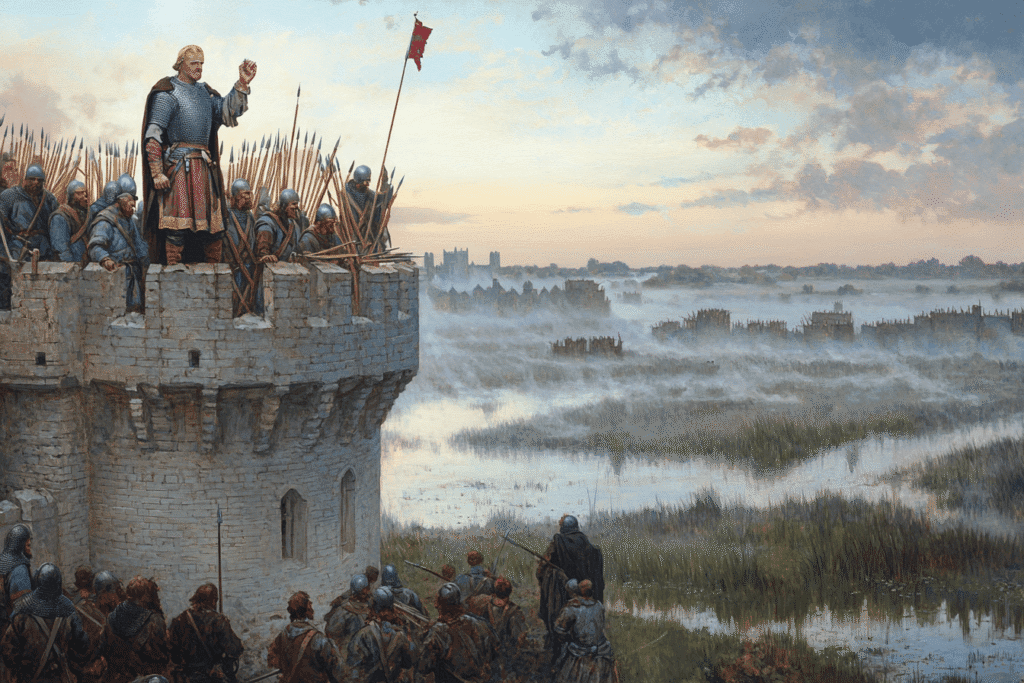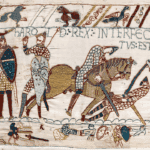
Hereward the Wake’s rebellion against Norman rule (1070–1071) stands as one of the most audacious acts of resistance in post-Conquest England. His campaign exploited the Fenland marshes to defy William the Conqueror’s authority, leaving a legacy that transformed him into a symbol of English defiance.
The Enigmatic Rebel: Origins and Early Life
Hereward was born in 1035 in Lincolnshire to a noble family of Danish descent, Hereward’s mixed heritage positioned him between the Anglo-Saxon and Viking worlds. He was banished from England as a youth for rebellious behavior, he became a mercenary in Flanders, gaining military experience that later shaped his guerrilla tactics.
In 1067 he returned to England. He found that his family estate in Bourne had been seized. His father, Leofric, was dead. Normans sat fat and smirking in his family hall. His brother’s head, legend says, was mounted above the gates. The land he knew was unrecognizable – a place where Saxon lords bowed to French-speaking newcomers, where abbeys were looted, and where loyalty to the old kings counted for nothing.
Hereward’s response was swift and brutal: he killed the Normans responsible, then gathered a band of loyal followers and began a campaign of guerrilla warfare against the invaders.
By 1070, Hereward had become the rallying point for English resistance in the Fens, a region of marshes and waterways that provided natural defenses against Norman cavalry. The Isle of Ely, surrounded by treacherous bogs, became his stronghold. It was from here that he launched raids against Norman positions, often at night, striking swiftly and vanishing into the mists before the enemy could retaliate.

The Peterborough Raid (1070)
The political situation in England was volatile. King Sweyn Estrithson of Denmark, sensing an opportunity to reclaim influence in England, sent a fleet to join the English rebels and Hereward quickly formed an alliance with them. Together, they planned a bold strike against one of the richest and most symbolically important targets in the region: Peterborough Abbey.
Peterborough was not just a religious center; it was a repository of immense wealth, with golden chalices, jeweled reliquaries, and illuminated manuscripts. The abbey had recently come under the control of a new Norman abbot, Turold, who replaced Hereward’s uncle, Abbot Brand. To the rebels, this was a double affront: the loss of a family connection and the imposition of Norman authority on a sacred English institution.
Hereward’s stated justification for the attack was to save the abbey’s treasures from falling into Norman hands. He claimed he would rather see them in the possession of fellow Englishmen or their Danish allies than used to enrich the conquerors
The Attack
The attack was meticulously planned. Hearing that Abbot Turold had arrived at Stamford, 15 miles away, with 160 mounted knights, Hereward decided to strike before the Normans could fortify their position. In the early dawn, ships slipped silently from Ely, carrying Hereward, his men, and the Danes across the waterways to Peterborough.
The abbey was well-defended. The monks, loyal to their new abbot and fearful of the rebels, refused to open the gates. As Hereward’s forces tried to force entry, the defenders hurled rocks and boiling water down upon them. The assault quickly escalated. Incensed by the resistance, Hereward’s men set fire to the surrounding buildings, burning nearly all of Peterborough except for one house. The Bolhithe Gate was torched, and the attackers finally broke into the abbey precincts.
Once inside, the rebels stripped the abbey of its treasures. Gold and silver ornaments, precious relics, and even the monks themselves were seized. All but one monk, who lay ill in the infirmary, were taken captive. The loot was loaded onto ships, and the raiders returned to Ely, their holds heavy with plunder.

According to the Peterborough Chronicle, after the attack, the Danes quickly accepted terms from William the Conqueror and returned to Denmark, taking the treasures with them. The Chronicle notes that the monks consoled themselves with the knowledge that the plunderers did not go unpunished, as the Danish fleet was scattered by storms on its return voyage, and much of the loot was lost.
William Responds
The attack on Peterborough sent shockwaves through Norman England. It was not just the loss of wealth that stung, but the symbolic blow to Norman authority. Hereward’s ability to strike at will, even against fortified targets, exposed the vulnerability of the new regime and inspired further resistance.
King William responded with characteristic ruthlessness. He raised an army and began a campaign to root out the rebels. Castles were built to secure the region, and trusted Norman followers were installed in positions of power. The king himself directed operations from his new castle at Cambridge, determined to crush the last vestiges of English resistance

The Isle of Ely: Fortress in the Fens
The marshes of Ely became Hereward’s stronghold, where he orchestrated a masterclass in asymmetric warfare, exploiting the waterlogged terrain which neutralized Norman cavalry.
Joined by Morcar, the former Earl of Northumbria, and other dispossessed nobles, Hereward prepared for a desperate stand on the Isle of Ely. The Normans, frustrated by the natural defenses of the Fens, attempted to build a mile-long timber causeway to reach the rebels. However, the structure collapsed under the weight of armor and horses, drowning many of the attackers.
A second attack was repelled when Hereward set fire to peat beds, trapping his enemies between inferno and floodwaters.
In a bizarre episode, the Normans employed a witch to curse the defenders from a wooden tower, hoping to break their spirit. Hereward responded by setting fire to the tower, sending the witch tumbling to her death – a story that, whether true or not, added to his legend.
Eventually, William’s persistence paid off. According to some accounts, he bribed Ely’s abbot, Thurstan, to reveal hidden paths through the marshes to the Normans. This enabled a successful assault where the Normans were able to overcome the English with sheer numbers, finally capturing Ely.
Morcar was imprisoned for life, but Hereward managed to escape, vanishing into the mists of history. His ultimate fate remains unknown, but his legend endured, inspiring generations of Englishmen as a symbol of resistance to tyranny.

The Mystery of Hereward’s Fate
Sources conflict on his post-siege life. The Gesta Herewardi claims he negotiated peace with William, regaining his lands in exchange for loyalty. Other accounts suggest he continued raiding until killed by Norman knights. Local legends insist he vanished into the Fens, with 12th-century reports of “Hereward’s Castle” becoming a pilgrimage site for dissenters.
Like his fictional counterpart Robin Hood, Hereward became a folk hero – a dispossessed noble defending the oppressed, albeit with less altruism. His rebellion was less a coordinated insurgency than a personal vendetta elevated by circumstance. Yet his ability to humiliate the Conqueror secured his place in history.




